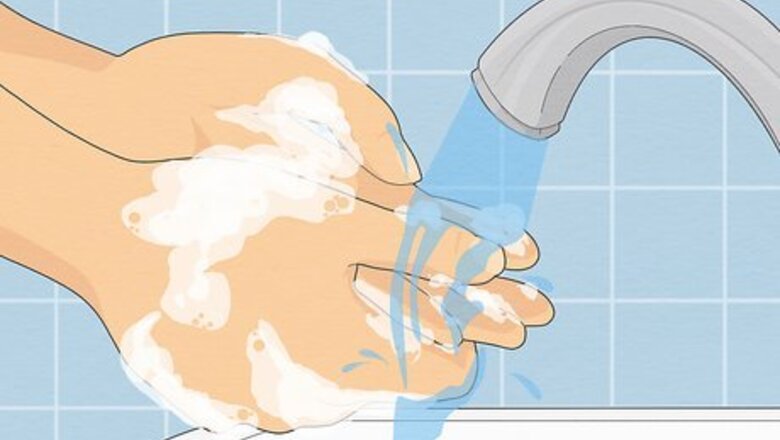
views
- Clean the wound with running water to remove dirt, debris, and bacteria.
- Apply pressure with a gauze or clean towel for 15 minutes to stop the bleeding.
- Reduce swelling with a cold compress or an ice pack for 10 minutes at a time.
Wash your hands and examine the wound.
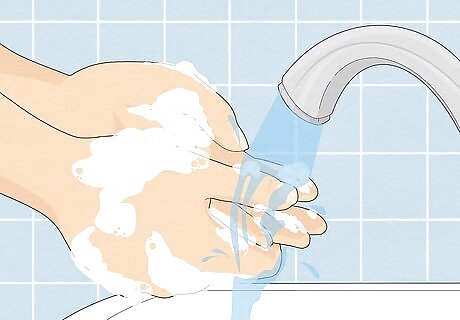
Make sure that your hands are as clean as possible to prevent infection. Before you start treatment, check for any injuries associated with the cut lip, and request medical assistance if needed. If you're treating someone else, ask them to remove any objects around the cut, like food, gum, or jewelry. Try not to breathe or cough/sneeze near the site of the wound. Don’t blow on the wound, either, since that can introduce bacteria.
Clean the wound with running water.
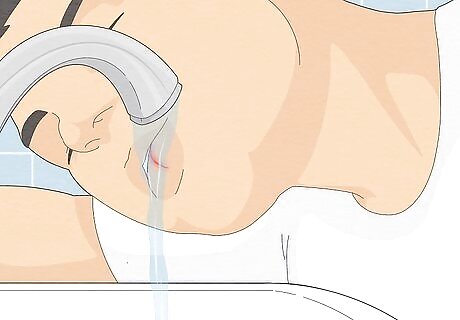
This step helps prevent infection and reduces the risk of scarring. If there are objects in the wound itself—like dirt particles or pebbles—remove them by having the injured person place the wound under a running faucet until it’s clean. If that’s uncomfortable for the person, fill a glass with water and pour it over the wound. Keep refilling the glass until you’ve washed the matter out of the wound. Use a cotton swab dipped in hydrogen peroxide to deep clean the wound. Just be sure the injured person does not accidentally swallow any peroxide. Tip: If you're treating someone else, confirm that they're up-to-date on their vaccines. The injured individual could be at risk for a tetanus infection if the injury involved metal or other dirty items or surfaces.
Apply pressure with gauze or a towel.
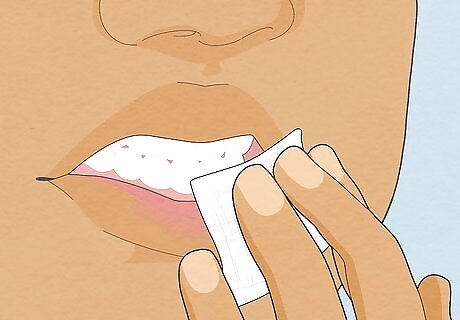
It's best if the person who is bleeding applies pressure to their own lip. If you need to help, though, be sure to wear clean rubber gloves. Using a clean towel or piece of gauze or a bandage, apply gentle but firm pressure to the cut for a full 15 minutes. If the towel, gauze, or bandage becomes completely saturated with blood, apply additional gauze or bandages without removing the first layer. Apply the pressure inward, toward the teeth, jaw, or gums. If this is uncomfortable for the injured person, place gauze or clean cloth between the person’s teeth and lip, then resume applying pressure.
Check the wound after 15 minutes.
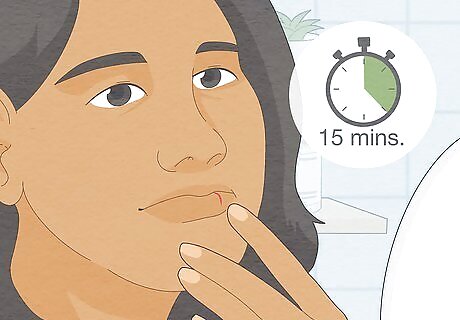
The cut may trickle or spot blood for upwards of 45 minutes. If there is steady bleeding after the first 15 minutes, you may need to seek medical help. The mouth—including gums, tongue, and lips—has a lot of blood vessels and a heavy blood supply, so oral lesions tend to bleed more than cuts on other parts of the body.
Contact a medical professional if the bleeding continues.
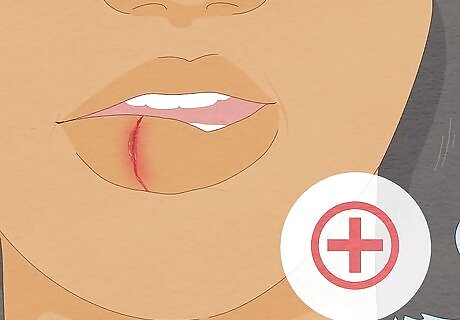
Reach out if the bleeding hasn't stopped after 15 minutes of steady pressure. Similarly, if the injured person has trouble breathing or swallowing, if they have loose or missing teeth, or if you can’t get the wound completely clean, seek medical attention. Do this as soon as possible, as the chances of infection increase the longer you leave a wound open and bleeding. If you have any doubt, make sure to contact a doctor. If the cut goes all the way through the lip, it's important to seek medical assistance immediately. If the cut is on the red part of the lip as well as on the normal colored skin above or below the lip (crosses the vermillion border), the injured person likely needs stitches. Stitches will reduce the risk of infection and help make sure the wound heals in the best cosmetic way. Doctors recommend stitches if the cut is deep and gaping, meaning that you can place fingers on either side of the cut and gently pry it open with minimal effort. Doctors may also recommend stitches if there is a flap of skin that can easily be sutured. Don’t wait more than 8 hours maximum to get treatment for deep lacerations that need stitches. Otherwise, they may not heal properly.
Apply a topical antiseptic product or natural alternative.
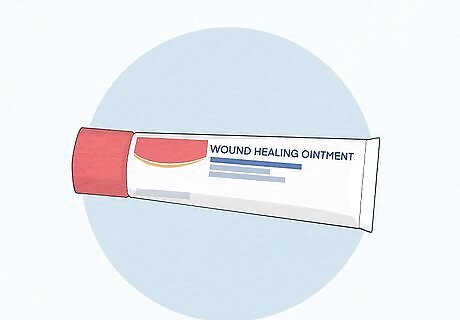
It's important to treat the wound so it heals cleanly. There is some disagreement in the medical world about whether antiseptic creams are necessary or even helpful, particularly if the creams are used excessively. However, some research does suggest they can be helpful in healing if used correctly and appropriately. If you do choose to use a topical antiseptic cream, you can buy one over the counter at any pharmacy or grocery/convenience store. If in doubt, ask your doctor or pharmacist which products might be best for your wound. Make sure you use your chosen product only as directed to avoid applying too much or too frequently. As an alternative, you can apply honey or granulated sugar to the wound. Sugar draws water out of the wound, preventing bacteria from getting the hydration they need to grow. Honey also has antibacterial properties. Studies have shown that applying sugar or honey to a wound before dressing it can reduce pain and prevent infection.
Use a cold compress to reduce swelling.
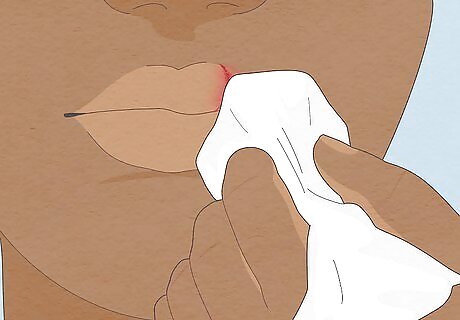
An ice pack can help soothe the pain and reduce inflammation. You can also use a few ice cubes wrapped up in a clean dish towel or clean sandwich bag. Apply a cold compress for 20 minutes on, followed by 10 minutes off. Don’t use a cold compress for more than 10 minutes at a time, as it could hurt the skin around your wound. If the cut is on the inside of the mouth, use an ice cube or a popsicle to keep the area cold.
Wait 3 to 4 days for the cut to heal.

Small cuts inside the mouth usually heal quickly. However, more serious injuries or deeper cuts may take longer to heal, especially if the cut is on a part of the lip that encounters a lot of movement during eating and drinking. If the injured person has seen a doctor, follow the doctor's instructions for care of the wound, including any medications prescribed (like taking antibiotics).
Restrict any mouth movement as much as possible.

Movement can potentially reopen the wound. If the injured person opens their mouth too wide—when yawning, laughing hard, or taking large bites of food, for example—this could cause unnecessary discomfort and may reopen the wound. Try to keep the mouth closed as often as possible to avoid any further trauma.
Follow a soft diet.
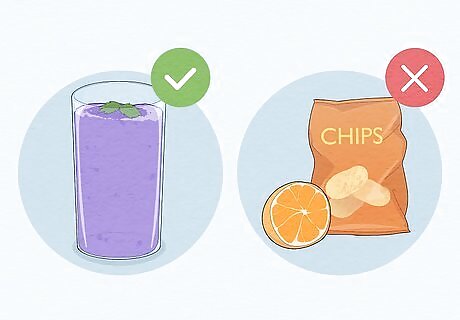
The less chewing the injured person does, the less likely their wound will reopen. Drink as many fluids as possible to keep the body and tissues hydrated; this also helps prevent the wound from reopening. Avoid contact between the wound and salt or citrus, as this can cause uncomfortable burning pain. Avoid eating hard, crunchy, or sharp foods like potato or tortilla chips. Run warm water over the wound after meals to clean out any particles that may have been left behind. Contact a doctor if the injured person is having difficulty eating or drinking due to the cut.
Report signs of infection to a doctor immediately.

Sometimes things don’t go your way even if you're prepared. Contact a medical professional immediately if you observe the following symptoms: A fever of 100.4ºF or higher Unusually low body temperature Redness, swelling, increased warmth or pain, or pus in the wound Decreased urination Rapid pulse Rapid breathing Nausea and vomiting Diarrhea Difficulty opening the mouth Redness, tenderness, or swelling of the skin around the cut


















Comments
0 comment